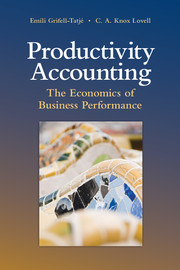Book contents
- Frontmatter
- Dedication
- Contents
- List of Tables
- List of Figures
- Preface
- 1 Introduction
- Part I Productivity and Profitability
- Part II Productivity and Profit
- 4 Profit Change: Its Generation and Distribution
- 5 Decomposing the Quantity Change and Price Change Components of Profit Change
- 6 Decomposing the Productivity Change Component of Profit Change
- Part III Productivity, Cost, and Return on Assets
- Bibliography
- Author Index
- Subject Index
6 - Decomposing the Productivity Change Component of Profit Change
Published online by Cambridge University Press: 05 January 2015
- Frontmatter
- Dedication
- Contents
- List of Tables
- List of Figures
- Preface
- 1 Introduction
- Part I Productivity and Profitability
- Part II Productivity and Profit
- 4 Profit Change: Its Generation and Distribution
- 5 Decomposing the Quantity Change and Price Change Components of Profit Change
- 6 Decomposing the Productivity Change Component of Profit Change
- Part III Productivity, Cost, and Return on Assets
- Bibliography
- Author Index
- Subject Index
Summary
Introduction
The research objective in this chapter is the same as in the ratio-oriented Chapter 3: to tell a story about the economic drivers of the productivity change component of change in financial performance. The models developed in Chapters 4 and 5 do not meet this objective. They are constructed solely from accounting information, and they generate valuable information on productivity change and its financial impact, but not on the economic drivers of productivity change and their financial impacts.
We introduce best practice technology and varying degrees of optimization in order to identify the economic drivers of productivity change and to quantify their contributions to profit change. Because best practice technology is unknown, it must be estimated, and this, together with a sufficiently large sample to make estimation feasible, is the price to be paid for gaining insight into the economic drivers of productivity change. The analytical framework we develop in this chapter has similarities with and differences with the framework we developed in Chapter 3. The analytical techniques we use to decompose the productivity effect are similar, but reliance on optimization to establish best practice benchmarks is new. Although optimization is used to establish benchmarks, we do not assume that firms are successful optimizers. Indeed change in the ability to optimize is a key driver of productivity change. A significant difference between the two analytical frameworks is the appearance of an effect that drives a wedge between the quantity effect and the productivity effect. The analytical framework in Section 6.2 incorporates investor input, and the effect is an earnings on capital expansion effect. The analytical frameworks in Sections 6.3 and 6.4 do not incorporate investor input. In Section 6.3 the effect is a margin effect. The earnings on capital expansion effect and the margin effect appeared in Chapters 4 and 5. In Section 6.4 the effect is an activity effect, which is new. All three effects complement the productivity effect in the quantity effect, but in different ways, and as we demonstrate with empirical applications, each of these effects can be large relative to the productivity effect.
- Type
- Chapter
- Information
- Productivity AccountingThe Economics of Business Performance, pp. 233 - 274Publisher: Cambridge University PressPrint publication year: 2015



